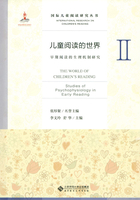
Preface
A generation ago The World of Children’s Reading would not have been possible.A few intrepid scholars had undertaken pioneering studies of Chinese reading.Beginning in the 1990s and 2000s increasing numbers of Chinese students streamed to the United States, Canada, Great Britain and elsewhere to study reading with scholars who for one reason or another had become interested in Chinese reading.
My own interest in Chinese reading began in the early 1980s during a trip to China as a member of a delegation jointly sponsored by the United States Department of Education and the Chinese Ministry of Education.To a provincial boy like me who had grown up in the Midwest of the United States, everything was amazingly different.Men and women alike wore a simple variant of the Zhongshan suit.Streets were flooded with bicycles, people walking, occasional donkeys pulling carts, buses belching fumes and rattle trap taxis threading through the teaming mass.The only cars we saw were black chauffeur-driven Russianmade limousines carrying important people.
In the schools, children sat with hands clasped behind their backs, stood to recite their lessons, sat back down when the teacher said, “Be seated”.The discipline seemed perfect.Even in kindergarten, children steadfastly focused on the teacher despite foreigners filling into the room, snapping pictures, whispering with their interpreters.Tones made understanding and repeating simple Chinese phrases difficult for us American visitors.Chinese characters were fascinating, but so strange to us that we could not remember and write even simple characters from the first grade primer.
The big question that motivated the expanding group of Chinese reading researchers was: Are the processes in reading Chinese unique to Chinese or are reading processes universal? Many of the chapters in the four volumes of The World of Children’s Reading address this question.All I will say here is that the answer depends upon level of abstraction.At a high enough level of abstraction, reading processes will be seen to be universal.Skillful reading of any language depends upon an intimate understanding of how the writing system represents speech and meaning.At the level of elemental language processes there are certain to be differences among languages.A look at a Chinese word written in characters and an English word written in Roman letters will tell you that much.Productive research works within these boundaries trying to identify, for instance, which components of the processes involved in reading different languages are easy for children and which are challenging, at least for some children.
Beyond elemental processes in reading, culture, traditions of pedagogy, and, perhaps, structural features of language may lead to differences in receptive and productive uses of various languages.Some have claimed that Chinese people and other East Asian people are disposed to an “indirect”or “nonlinear” form for essays, in which the thesis is left unstated or stated at the end, which may interfere with composing an American-style essay in which the thesis is stated directly at the beginning.This claim does not seem to be true, either.Still others have maintained that life-long participation in dialogue founded on the values of harmony and respect for teachers and other elders would cause a “discourse mismatch”, making it difficult for Chinese students to challenge others in vigorous give and take.But in fact Chinese students readily argue with others, when the situation requires or affords this stance.
The World of Children’s Reading incorporates the full range of issues investigated in contemporary reading research and makes the research on these issues accessible in Chinese to a wide audience.There is every reason to believe that wide dissemination of the series books will lead to improvement the qualities of the teaching of reading, curriculum design, and services for children with special needs in China.
Richard C.Anderson
Center for the Study of Reading
University of Illinois